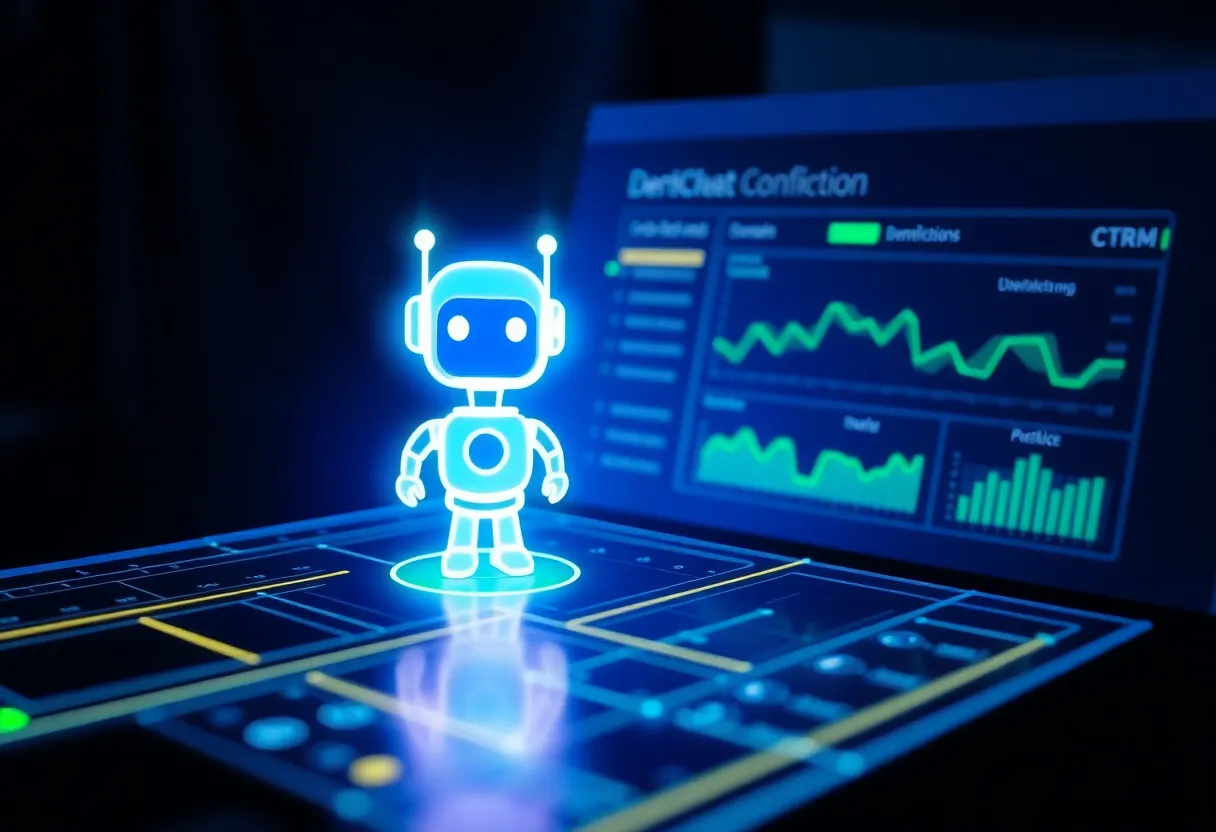If you run a contracting business, you know the toughest jobs often happen away from a desk. Calls come in while you’re on a ladder, texts arrive after hours, and website leads pile up over the weekend. An AI receptionist keeps you responsive across phone, text, and chat—so you book more jobs without hiring more staff.
Why contractors need an AI receptionist now
Two realities are colliding: customers expect fast, mobile‑friendly replies, and trades are juggling tight crews. Job openings in construction remain high by historical standards, making coverage hard on small teams. In May 2025, there were 273,000 open construction jobs nationwide, per the U.S. Job Openings and Labor Turnover Survey. See the latest release for details at the Bureau of Labor Statistics (BLS).
That’s why an AI receptionist is so useful: it never misses a call, answers repetitive questions instantly, and captures every lead while you’re on site.
Research highlight
- 98% of U.S. adults own a cellphone and 91% own a smartphone, making SMS and mobile chat the default way to reach homeowners (Pew Research Center, Nov. 13, 2024). Source: Pew Mobile Fact Sheet.
- Customer support agents with AI assistance handled 14% more issues per hour on average, with the biggest gains for newer staff (NBER working paper 31161, revised Nov. 2023). Source: Generative AI at Work.
- Homeowner spending on improvements and maintenance is projected to reach about $526B by Q1 2026, keeping demand steady for local contractors (Harvard Joint Center for Housing Studies, Apr. 17, 2025). Source: LIRA outlook.
12 must‑have AI receptionist features for contractors
These apply across trades—HVAC, plumbing, electrical, roofing, remodeling, landscaping, and more.
1) 24/7 answering and instant response
Most homeowners contact multiple contractors and go with whoever replies first. Your AI receptionist answers immediately at all hours, captures the lead, and confirms next steps—no overtime required.
2) Smart lead capture and qualification
Great leads share the same basics. Configure the AI to collect name, phone, address, service needed, timeline, and ballpark budget. Add trade‑specific prompts (e.g., tonnage, SEER, fixtures, square footage, roof type) so you can prioritize profitable jobs.
- Auto‑tag inquiries by service area and urgency
- Route emergencies differently than routine quotes
- Email a clean summary to the right team member
3) Contractor‑friendly scheduling and dispatch
Offer real‑time availability and book estimates or service windows without back‑and‑forth. Your AI can propose slots that respect drive time, crew size, and on‑call rules, then drop a confirmation onto your calendar.
4) Multi‑channel: voice, SMS, and web chat
Your buyers live on their phones. Let them reach you however they prefer: phone calls, text messages, or your website chat. Conversations continue seamlessly across channels so nothing gets lost.
5) Up‑to‑date knowledge from your website
Contractors change pricing, service areas, and offerings often. Your AI receptionist should automatically refresh its knowledge from your site—no manual re‑training—so answers stay accurate.
6) Spam and robocall screening
Protect your time. The AI can screen obvious spam, route repeat sales pitches to voicemail, and pass through known customers or urgent jobs.
7) Rules for escalation and live handoff
Blend automation with a human touch. If a caller is a VIP, the AI can ring through to your cell. If the conversation gets complex, it hands off to a teammate with full context in the message thread.
8) Bilingual support
Serve more neighbors with bilingual voice and chat—typically English and Spanish—so homeowners can ask questions and book in their preferred language.
9) Project intake that captures job details
Standardize what you need to quote: materials, finishes, photos, access notes, preferred dates, and constraints. The AI can collect the info and email it to your inbox so your foreman shows up prepared.
10) Ballpark estimates (with guardrails)
For common jobs, offer non‑binding ranges based on your pricing guidance. Make it clear they’re preliminary until you inspect on site.
11) Automated follow‑ups and reminders
The fortune’s in the follow‑up. Have the AI send polite nudges if a homeowner goes quiet, appointment reminders to reduce no‑shows, and “thank you” notes after completion.
12) Analytics and emailed call summaries
See which channels drive leads, what questions buyers ask, and how quickly they convert. Call and chat summaries delivered to your email make it easy to coach the team and refine offers.
Pro tip
Start by intercepting after‑hours calls only for one week. Compare booked jobs and missed calls before/after, then roll the AI receptionist to daytime overflow.
Compliance basics (TCPA & good texting hygiene)
Texting brings fast responses, but U.S. rules matter. Under a 2024 FCC declaratory ruling, calls using AI‑generated or “artificial” voices are treated as artificial/prerecorded under the TCPA, which generally requires prior express consent for many calls and texts to mobile numbers. Read the ruling summary at the Federal Communications Commission.
- Get clear consent before marketing texts; always honor STOP/UNSUBSCRIBE
- Use transactional vs. marketing messaging appropriately
- Identify your business in messages and provide contact options
- Record how/when consent was obtained
Quick implementation checklist
- 1 Define service areas, emergencies, and working hours
- 2 List intake questions per trade (e.g., tonnage, fixtures, roof type)
- 3 Connect your calendar and set bookable windows
- 4 Write plain‑English policies (pricing disclaimers, warranties)
- 5 Decide escalation rules (VIPs, repeat clients, vendor calls)
- 6 Turn on bilingual flows if you serve multilingual neighborhoods
- 7 Set follow‑up cadences (e.g., +1 day, +3 days, +7 days)
- 8 Track conversions by channel and top questions weekly
- 9 Review one week of transcripts to tighten scripts and pricing ranges
- 10 Document consent and opt‑out handling for texts
What ROI looks like for contractors
AI doesn’t just answer calls—it changes your team’s capacity. Rigorous research shows AI assistance can increase hourly resolution rates by double digits without hurting customer sentiment, especially helping newer team members. (NBER, 2023; see Research highlight.) Translate that to the field: if your crew converts just one extra job per week because you replied instantly, the monthly ROI often eclipses software costs.
Practical targets for month one:
- Capture 100% of after‑hours calls and chats
- Respond to new leads in under 60 seconds, 24/7
- Reduce scheduling back‑and‑forth to a single message
- Cut no‑shows with automatic reminders
Why contractors choose Small Business Chatbot
Small Business Chatbot was built for local service teams. You can get set up in under a minute—just add your website—and the AI receptionist learns from your pages automatically, then emails action items and conversation history to your inbox after each interaction.
- Voice agent with a dedicated phone number and optional texting
- Website chat that captures leads and answers FAQs instantly
- Automatic refresh from your website so info stays current
Need to connect your CRM or calendar? See popular options on our integrations page. Want proof it works? Read real customer stories on our reviews page.
Frequently asked questions for contractors
- What exactly is an AI receptionist for contractors?
- It’s a voice and chat assistant that answers calls, texts, and website chats; collects job details; schedules visits; and hands off to your team when needed.
- Can it schedule jobs while I’m on a ladder?
- Yes. It proposes your available windows, books the slot, and emails or texts confirmations so you don’t have to stop work to coordinate.
- How does it qualify leads?
- You set the rules (service area, job types, budget range). The AI asks the right questions and tags urgency so you focus on the best opportunities first.
- Will it give quotes?
- For repeatable jobs, it can share non‑binding ranges using your guidance and disclaimers. For custom work, it schedules an estimate visit instead.
- Does it handle Spanish?
- Yes. You can enable bilingual flows so homeowners get help in English or Spanish.
- What about consent and texting rules?
- You can gather consent during intake and include opt‑out language in every message. See our compliance section above for best practices and the applicable FCC framework.
- What if the AI gets stumped?
- It escalates to a human with call or chat context attached. You control the handoff rules.
- How fast can I go live?
- Most contractors launch in under a day. Start after‑hours first, then expand to daytime overflow once you’re comfortable.
Sources mentioned in this guide include the Bureau of Labor Statistics (JOLTS, May 2025), Pew Research Center (Mobile Fact Sheet, 2024), the Harvard Joint Center for Housing Studies (LIRA, 2025), and the FCC’s 2024 TCPA AI voice ruling. See inline citations above for details.



